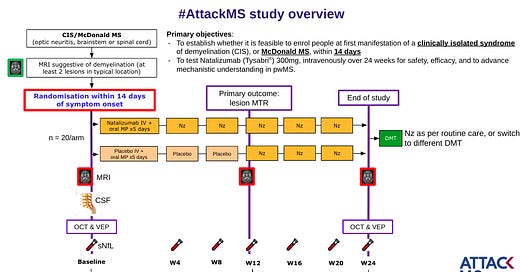Nothing is hidden. If you look carefully, you will find all you need to find. In the study of newly diagnosed Scottish patients with MS, close to 40% had hidden disabilities such as depression, anxiety, fatigue, sleep disturbance, cognitive impairment and pain. Are these MS-related problems really hidden? Yes, hidden from the eye but detectable by simply asking the right questions and assessing the function of the nervous system using standard techniques.
A remarkable 26% of subjects were on antidepressants, 18% were unemployed, 36% had motor difficulties, 36% had balance, incoordination, double vision or swallowing problems and 12% had bladder or bowel problems at symptom onset.
These observations are not new and have been well documented in other studies. This study confirms that early MS is not really early MS, and a large proportion of pwMS have evidence of the damaging effects of untreated inflammation on the function of the nervous system.
In the majority of these subjects, the hidden symptoms remained unchanged, but in approximately a quarter, the symptoms improved after the diagnostic period. DMTs had no major influence on the hidden disability burden over a period of about one year. However, subjects treated with fingolimod and cladribine, higher efficacy DMTs, had a more favourable outcome. Is this not an argument for flipping the pyramid and using high-efficacy DMTs first-line in more pwMS? Is it not time to leave the less effective platform therapies as a historical footnote? In this cohort, over 1 in 5 patients were started on injectables (interferon-beta or glatiramer acetate).
What is quite remarkable is that this study represents 45% of the newly diagnosed people with MS in Scotland over the study period, with an average time between symptom onset and diagnosis of 18 months. This is a problem. If early inflammation imprints on the brain and spinal cord, waiting 18 months to be diagnosed and then a further period of time to be started on treatment comes at a cost. Unfortunately, the latter information is not reported in the paper. I am aware from other studies in the UK that the time from diagnosis to initiating DMTs is variable and can take anything from 2 months to 9 months depending on the kind of service the patients attend, i.e. a specialist centre versus a district general hospital requiring patients to then be referred to a specialist centre for treatment.
These delays due to systemic problems in the NHS cost our patients’ brain and spinal cord. These delays are the main reason we produced the ‘Brain Health: Time Matters’ policy document and the follow-on quality standards (see paper 2 below) to try and create the carrot and stick to sort out the unnecessary and unacceptable delays in the diagnosis and management of pwMS.
We are even taking this ‘Time Matters’ approach to the extreme with our #AttackMS trial, in which we are comparing pwMS started on natalizumab within 2 weeks of symptom onset to those starting natalizumab after 2 months. Yes, we really think time matters in MS; this study will tell us if weeks matter.
In our International Quality standards, which were developed by international consensus, we state the diagnosis of MS should be made within 2 months and a DMT treatment offered within a similar timeframe. Please note these are just the core standards, and we challenge the MS community to do better than this.

Sadly the NHS fails on these metrics, and the costs to pwMS in the UK is likely to be substantial. What can we do about it? We need more resources and a more responsive system to deal with MS. This can be done. The NHS has proven that if there is a will, there is a way to achieve things. It has been done for the management of stroke and, to some extent, with the two-week pathway for suspected cancer. Why can’t we get a 2x2 month pathway for the diagnosis and treatment of MS? Is this too little to expect from our national health service?
Paper 1
Glasmacher et al. The influence of disease-modifying therapy on hidden disability burden in people with newly diagnosed relapsing-remitting multiple sclerosis. Mult Scler Relat Disord. 2022 Apr 30;63:103837.
Background: In addition to motor disability, "hidden disability" such as depression, anxiety, fatigue, sleep disturbance, cognitive impairment and pain is a major complaint of people with multiple sclerosis. We explored changes in hidden disability burden in the early post-diagnostic period and examined the hypothesis that disease modifying therapies have a beneficial effect on hidden disability burden.
Methods: Adults with recently diagnosed (< 6 months) relapsing-remitting multiple sclerosis (n = 440, mean age 37.4 ± 10.4, 76% female), from a national multicentre cohort study (FutureMS) underwent testing with clinical and neuropsychological instruments as well as brain MRI at baseline and after 12-months. Disease modifying therapies were only started after baseline assessment and were classified into injectables (n = 70, interferons, glatiramer acetate), other DMTs (n = 215) and no DMT (n = 117, reference). Sensitivity analyses were undertaken using alternative classifications (disease modifying therapy vs none, and a 3-category system). We performed latent transition analysis with hidden disability burden as the latent variable including propensity score weights.
Results: We identified three classes with low (58%), moderate (25%) and high (17%) hidden disability burden. 70% did not transition ("unchanged", reference), 26% transitioned into a lower burden class ("improvement") and 4% transitioned into a higher burden class ("worsening"). Median treatment duration was 11 months (IQR 9-12). Injectables [OR 1.3 (95%CIs 0.7, 2.3); P = 0.4] and other DMTs [OR 1.4 (95%CIs 0.9, 2.1); P = 0.2] were not associated with significant change in hidden disability burden in either direction ("improvement" or "worsening"). In the alternative 3-category classification, category 2 treatment (fingolimod, cladribine, n = 22) was associated with improvement [OR 4.3 (2.6, 7.0); P < 0.001].
Conclusion: Hidden disability was present in most newly diagnosed people with multiple sclerosis. The majority remained unchanged and approximately a quarter improved over the immediate post-diagnostic period. Disease modifying therapy had no significant influence on hidden disability burden in the study period of one year following diagnosis. The trend towards favourable outcomes with fingolimod and cladribine should be interpreted with caution due to the small sample size. Our exploratory data are observational, with scope for attendant biases, but highlight the need for further study including longer-term evaluation as well as randomised trials for non-motor disability.
Paper 2
Hobart et al. International consensus on quality standards for brain health-focused care in multiple sclerosis. Mult Scler. 2019 Nov;25(13):1809-1818.
Background: Time matters in multiple sclerosis (MS). Irreversible neural damage and cell loss occur from disease onset. The MS community has endorsed a management strategy of prompt diagnosis, timely intervention and regular proactive monitoring of treatment effectiveness and disease activity to improve outcomes in people with MS.
Objectives: We sought to develop internationally applicable quality standards for timely, brain health-focused MS care.
Methods: A panel of MS specialist neurologists participated in an iterative, online, modified Delphi process to define 'core', 'achievable' and 'aspirational' time frames reflecting minimum, good and high care standards, respectively. A multidisciplinary Reviewing Group (MS nurses, people with MS, allied healthcare professionals) provided insights ensuring recommendations reflected perspectives from multiple stakeholders.
Results: Twenty-one MS neurologists from 19 countries reached consensus on most core (25/27), achievable (25/27) and aspirational (22/27) time frames at the end of five rounds. Agreed standards cover six aspects of the care pathway: symptom onset, referral and diagnosis, treatment decisions, lifestyle, disease monitoring and managing new symptoms.
Conclusion: These quality standards for core, achievable and aspirational care provide MS teams with a three-level framework for service evaluation, benchmarking and improvement. They have the potential to produce a profound change in the care of people with MS.
Subscriptions and donations
Paid subscriptions to MS-Selfie are being used to administer the Newsletter and associated MS-Selfie microsite that is currently in development. At the request of several readers, I have now added the option of making a one-off donation. To keep this initiative open to all readers, I would appreciate it if those who can afford a subscription, to please subscribe. For active paying subscribers, thank you; your contribution is much appreciated.
Thank you.
General Disclaimer: Please note that the opinions expressed here are those of Professor Giovannoni and do not necessarily reflect the positions of Barts and The London School of Medicine and Dentistry or Barts Health NHS Trust. The advice is intended as general advice and should not be interpreted as personal clinical advice. If you have problems, please tell your own healthcare professional who will be able to help you.















Share this post